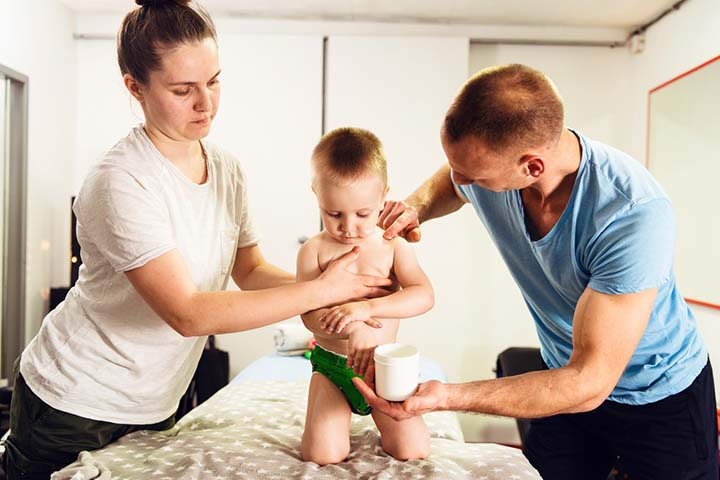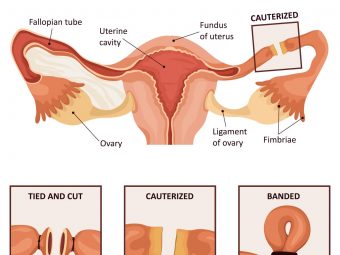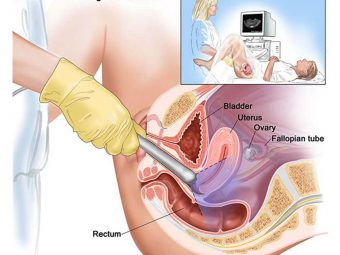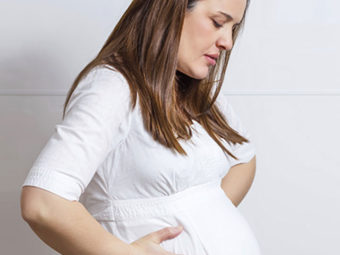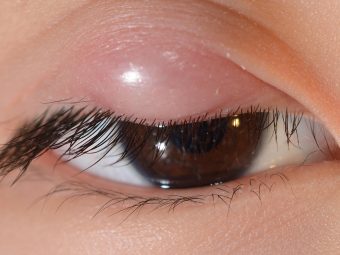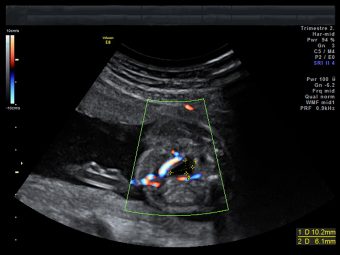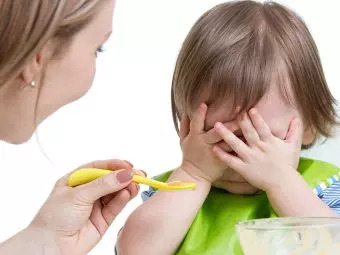
Image: Shutterstock
While acne is common in adults, toddler acne is rare. It is a chronic inflammatory skin disease of sebaceous glands (oil-producing cells). These oil glands are located at the base of hair follicles(1). Extra skin cells and oil may combine to block the hair follicle’s opening, which in turn plugs the oil glands leading to bacterial growth and multiplication, and eventually causing pimples or blemishes(2). Read on to know more about the causes, symptoms, treatment, and tips to reduce and prevent acne in toddlers.
Is Acne Common In Toddlers?
Acne can occur in toddlers, but it is rare(3).
Pediatric acne is divided into five subgroups(4).
- NeonataliXRelating to a child under 28 days of ageacne
Image: Shutterstock
- Infantile acne
- Mid-childhood acne
- Preadolescent acne
- Adolescent acne
Toddler acne falls in the mid-childhood acne category.
Symptoms Of Acne In Toddlers
Image: IStock
Mid-childhood acne is usually seen in the age group of one to seven years. The following are the symptoms of acne in toddlers.
- Red raised inflammatory papules on the skin surface
- Painful bumps
- Lesions mostly on the face, chest, and back
- Lesions appearing as open or closed comedo, which is commonly known as blackheads or whiteheads, respectively
- Inflammatory papules andpustulesiXA small pus-containing bump on the skin
 Quick fact
Quick factCauses Of Acne In Toddlers
Acne usually happens due to the circulation ofadrenaliXRelating to two glands situated above the kidneysandgonadaliXRelating to reproductive glands like ovaries or testisandrogeniX一个雄性激素hormones inthe blood(3). The secretion of androgens is usually low in children of one to seven years old. However, some substances or conditions might trigger the secretion of androgens. The following are some commonly seen reasons for acne in toddlers.
1. Dairy intake
Dairy intake has been proven to increase the incidence of acne in people between the ages of seven to 30years. It is believed that dairy, especially butterand cheese, intake can cause acne in toddlers, too. However, more research needs to be done to establish the relation of dairy consumption in toddler acne(1).
2. Irritants
Some irritants from soap or cleansers might trigger acne in toddlers with sensitive skin. This is much more common than many other triggers. Some skin lotions can also be irritants and may cause redness in sensitive skin. Skin irritation can also be caused by air fresheners, soaps, or lotions that are heavily perfumed.
3. Medicines
The use of medicines like antidepressants, birth control pills,steroidsiXSynthetic version of hormones produced by adrenal glands, etc., by breastfeeding mothers can cause acne in toddlers. However, there is limited research to establish a correlation.
4. Dietary changes
Dietary changes in a mother’s food might also cause skin problems leading to acne breakout in toddlers.
5. Hormones from maternal breast milk
Some researchers believe that the hormonal disturbances in the mother might get passed to babies viabreast milk. However, this requires further research(5).
Drooling of saliva from the baby’s mouth can lead to inflammation, eventually causing acne. Also use of rough fabric may irritate the sensitive skin of the baby.
Image: Shutterstock
In some toddlers, the acne might happen due to hormonal changes. The doctor might recommend blood tests in case hormonal abnormalities are suspected to be the cause(3).
Acne could also be caused due to genetics. If your child has a family history of acne, there is a likelihood that they may develop acne too.
How Do You Treat Acne in Toddlers?
Image: Shutterstock
Acne does not need treatment in toddlers. It is a self-limiting condition and resolves by itself. Treatment might be required only in a few rare cases.Dr. Anna H. Chacon, a board-certified dermatologist from Miami, Florida, says, “You should contact a doctor if your child has moderate-to-severe acne, painful cysts, or scars.” Establishing the cause of acne is essential in designing the treatment plan. The doctor will identify the underlying cause and suggest treatment accordingly. The following is the commonly proposed treatment plan for acne in toddlers(3).
- Topical application of benzoyl peroxide might be recommended.
- Application of topical antibiotic ointments such as erythromycin might help in treating acne.
- If the topical treatments do not help, the doctor might prescribe oral antibiotics like erythromycin, trimethoprim, etc.
医生会计划只在th痤疮治疗e basis of the underlying pathology. If some hormonal issues are suspected, then the endocrinologist will plan the treatment accordingly.
Tips To Reduce And Prevent Acne In Toddlers
Image: Shutterstock
Taking the following precautions can help reduce and prevent further the occurrence of acne in toddlers.
- Avoid scrubbing the area of the pimples with a towel.
- Keep the baby’s face clean with warm water.
- Do not squeeze the pimples since it might exacerbate the spread of acne lesions.
- Teach your toddler not to scratch or pop the pimples.
- Do not use lotions.
- Do not use over-the-counter (OTC) acne products since they might be harsh for your toddler’s skin.
- Use a bar of mild soap without fragrance to bathe the toddler.
- Use mild and gentle laundry detergents for the toddler’s clothes.
- Document the episodes of acne flare-out in the toddler and correlate it with the food you consumed.Your toddler might show a reaction to substances from the food items that passed through the breastmilk.
- 避免化工油乳液,保湿公关oducts, and creams for the baby. Use prescription-based mild products that are specifically designed for toddlers.
- You should consume a healthy andwell-balanced dietto prevent acne in toddlers.
Frequently Asked Questions
1. Can I shave a toddler’s ear acne?
Acne in toddlers is commonly seen on the back, face, neck, chest, and arms. However, occasionally they mightoccur in the ears. If you suspect acne development on the baby’s ears, then contact your pediatrician for a diagnosis and treatment.
2. Can teething cause acne in toddlers?
Teething cancause excess saliva to drool. It leads to the development of a drool rash around the baby’s mouth, and at times even on the neck and chest. Drool rash appears as a red and inflamed patch of the skin. It might be confused with acne, but the cause and management of drool rash are different from that of acne. The doctor will help you diagnose and treat the drool rash.
3. Can toddler acne be something other than just acne?
“Perioral dermatitis is a skin ailment that causes an inflammatory rash around a toddler’s mouth. It is frequently confused with acne because it manifests as little pink bumps and fluid-filled lesions that form, fade, and reappear over time,” observes Dr. Chacon. Additionally, skin infections or allergies such as eczema may also be confused with toddler acne.
4. Does coconut oil help with toddler acne?
Research suggests that coconut oil contains lauric acid that could kill Propionibacterium acnes, a bacteria that causes common acne (8). Thus, you may use coconut oil for baby acne after consulting your doctor or a pediatric dermatologist.
万博体育手机官方网站登录蹒跚学步的痤疮是不常见的。对于大多数孩子,雨万博体育手机官方网站登录e gets better in some time with little or, at times, no medical intervention. It may take a little time, but the healing is uneventful for most toddlers. You can teach them to practice certain hygiene routines to prevent acne formation. However, refrain from using any OTC drugs or ointments to manage acne in toddlers. You can consult a pediatrician to confirm the child’s diagnosis who may chalk out a safe treatment plan for your child.
Infographic: Possible Causes Of Acne Breakouts In Toddlers
When the hair follicles are clogged with oil or dead skin cells, the inflammatory skin condition ‘acne’ leads to pimples. Although toddler acne is uncommon, several potential causes exist, some of which are listed in the infographic below. Keep reading.

Illustration: Momjunction Design Team
Get high-quality PDF version by clicking below.
Download Infographic
Key Pointers
- The uncommon condition known as toddler acne is categorized as mid-childhood acne, seen in the age group of one to seven years.
- Lesions resembling black or whiteheads, red elevated inflammatory papules, and painful bumps are all signs of the condition.
- Dairy consumption, irritants, medications, dietary changes made by the mother, hormones from the mother’s breast milk, saliva drooling, and hormonal changes in the toddler are some of the causes of toddler acne.
- You should consult a doctor if the child has painful cysts, scars, or moderate to severe acne.
- Topical benzoyl peroxide and antibiotic ointments may be used in the treatment strategy.
References:
2.Acne; American Academy of Family Physicians.
3. BilgenGencleret ,Pediatric Acne; IntechOpen
4. Michael Samycia, MD and Joseph M. Lam,Infantile acne; US National Library of Medicine
5. TanjaKuiri-Hanninenet al.,Transient Postnatal Secretion of Androgen Hormones Is Associated with Acne and Sebaceous Gland Hypertrophy in Early Infancy; THE JOURNAL OF CLINICAL ENDOCRINOLOGY & METABOLISM
6. Julie Blatt and Peter A. Lee;Severe acne and hyperandrogenemia following dactinomycin; Medical and Pediatric Oncology
7.Acne in children; DermNet New Zealand Trust.
8.Treat acne with coconut oil and nano-bombs;



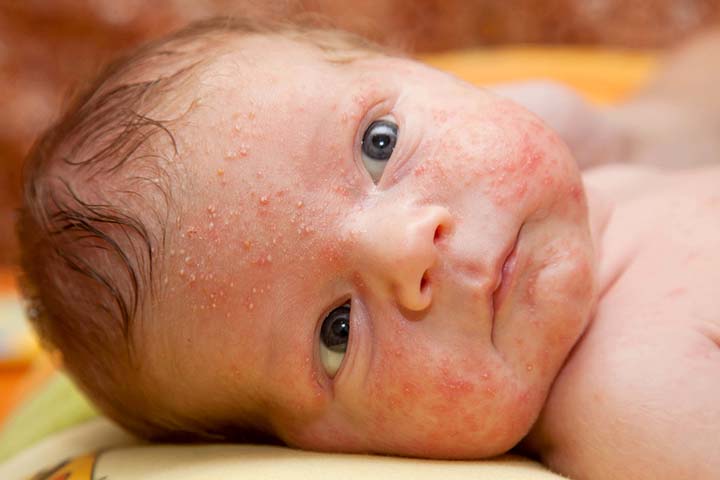
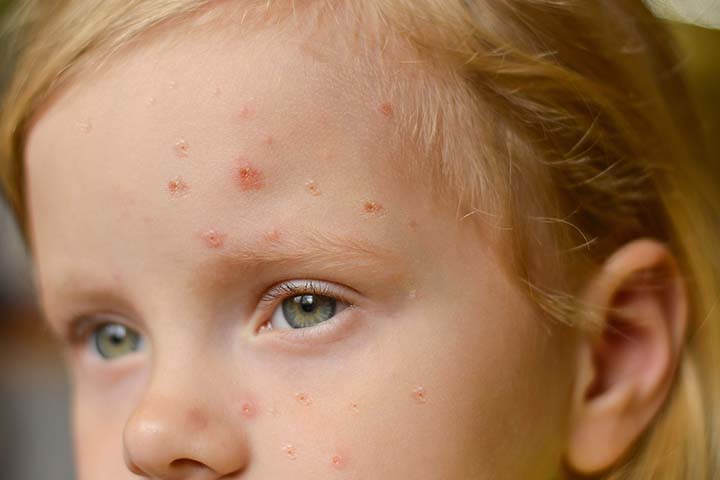

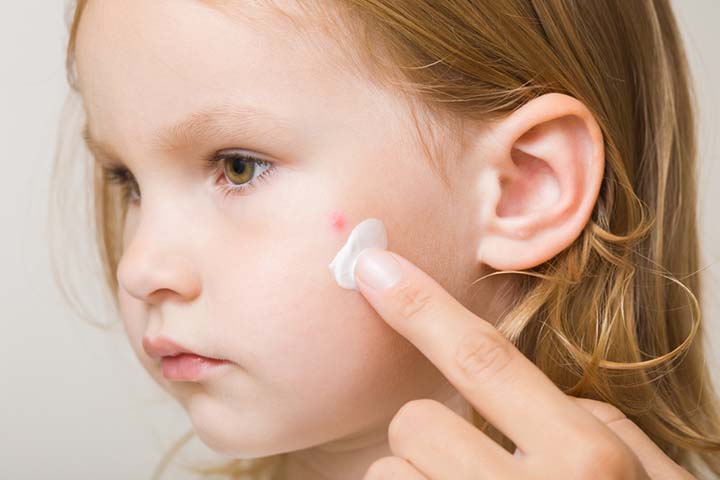
 Quick tip
Quick tip